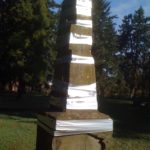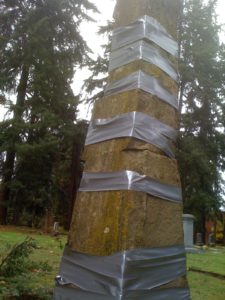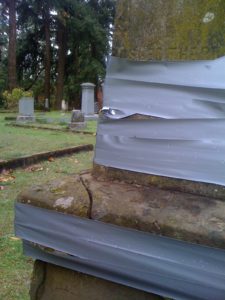 There’s a cemetery I sometimes walk through on my way to work, or on my way home. They’re mostly historic graves, though I think interments still take place from time to time. It’s quiet, with tall trees, a little poison oak, a caretaker’s trailer, and cigarette butts ankle deep at the entrance closest to campus, since the university has become a tobacco-free zone. And, one day, a duct-taped obelisk.
There’s a cemetery I sometimes walk through on my way to work, or on my way home. They’re mostly historic graves, though I think interments still take place from time to time. It’s quiet, with tall trees, a little poison oak, a caretaker’s trailer, and cigarette butts ankle deep at the entrance closest to campus, since the university has become a tobacco-free zone. And, one day, a duct-taped obelisk.
It is not true, as it turns out, that stone must be repaired with mortar. The obelisk had been reinforced with great care, though a slight displacement midway up suggested something like collision, damage fiercer than erosion. Topple and collapse are words that come to mind, but pull or shove seem more likely. 
I took pictures that day, finding the repaired monument odd, hopeful, improbable, off-kilter. I kept it in the back of my mind, and eventually worked it into a story I was writing. (You can read the story, “Give that Girl a Wilson Cigar!” in Saranac Review #13, out this fall.) I looked sometimes for other shored-up tombstones, but didn’t see any. My route is a cut-through, not a systematic zigzag. I’m not aiming for coverage, so there’s no telling how many repairs I might have missed. And I don’t cut through the cemetery every day, or even every week.
But when I do walk that way, I always pass that obelisk—always, in my mind’s eye, held together with tape. And then one day it wasn’t. It had been restored, smooth and sturdy, newly built to last. Not as shiny. Not the sparkle of silver in the sun. More enduring, in the monumental sense, but also more opaque.
 I didn’t recognize it at first. I thought I must be mistaken and looked around for the taped stone. Maybe it was really in a different row. But no. It was right in front of me, the same and not the same.
I didn’t recognize it at first. I thought I must be mistaken and looked around for the taped stone. Maybe it was really in a different row. But no. It was right in front of me, the same and not the same.
Maybe because I had the story I wanted, I never really paused to look at it closely, to read the restored inscription. I had already seen as much as I could see.